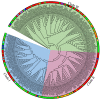Genomic Survey of Flavin Monooxygenases in Wild and Cultivated Rice Provides Insight into Evolution and Functional Diversities
- PMID: 36835601
- PMCID: PMC9960948
- DOI: 10.3390/ijms24044190
Genomic Survey of Flavin Monooxygenases in Wild and Cultivated Rice Provides Insight into Evolution and Functional Diversities
Abstract
The flavin monooxygenase (FMO) enzyme was discovered in mammalian liver cells that convert a carcinogenic compound, N-N'-dimethylaniline, into a non-carcinogenic compound, N-oxide. Since then, many FMOs have been reported in animal systems for their primary role in the detoxification of xenobiotic compounds. In plants, this family has diverged to perform varied functions like pathogen defense, auxin biosynthesis, and S-oxygenation of compounds. Only a few members of this family, primarily those involved in auxin biosynthesis, have been functionally characterized in plant species. Thus, the present study aims to identify all the members of the FMO family in 10 different wild and cultivated Oryza species. Genome-wide analysis of the FMO family in different Oryza species reveals that each species has multiple FMO members in its genome and that this family is conserved throughout evolution. Taking clues from its role in pathogen defense and its possible function in ROS scavenging, we have also assessed the involvement of this family in abiotic stresses. A detailed in silico expression analysis of the FMO family in Oryza sativa subsp. japonica revealed that only a subset of genes responds to different abiotic stresses. This is supported by the experimental validation of a few selected genes using qRT-PCR in stress-sensitive Oryza sativa subsp. indica and stress-sensitive wild rice Oryza nivara. The identification and comprehensive in silico analysis of FMO genes from different Oryza species carried out in this study will serve as the foundation for further structural and functional studies of FMO genes in rice as well as other crop types.
Keywords: S-oxygenation; abiotic stress; auxin biosynthesis; flavin monooxygenase; pathogen defense; wild rice.
Conflict of interest statement
The authors declare no conflict of interest.
Figures












Similar articles
-
Genetic Conservation of CBS Domain Containing Protein Family in Oryza Species and Their Association with Abiotic Stress Responses.Int J Mol Sci. 2022 Feb 1;23(3):1687. doi: 10.3390/ijms23031687. Int J Mol Sci. 2022. PMID: 35163610 Free PMC article.
-
Genome-Wide Identification and Characterization of PIN-FORMED (PIN) Gene Family Reveals Role in Developmental and Various Stress Conditions in Triticum aestivum L.Int J Mol Sci. 2021 Jul 9;22(14):7396. doi: 10.3390/ijms22147396. Int J Mol Sci. 2021. PMID: 34299014 Free PMC article.
-
Genome-wide survey and expression analysis of the OSCA gene family in rice.BMC Plant Biol. 2015 Oct 26;15:261. doi: 10.1186/s12870-015-0653-8. BMC Plant Biol. 2015. PMID: 26503287 Free PMC article.
-
Structure and expression analysis of early auxin-responsive Aux/IAA gene family in rice (Oryza sativa).Funct Integr Genomics. 2006 Jan;6(1):47-59. doi: 10.1007/s10142-005-0005-0. Epub 2005 Oct 1. Funct Integr Genomics. 2006. PMID: 16200395
-
Flavin-containing monooxygenases in plants: looking beyond detox.Trends Plant Sci. 2007 Sep;12(9):412-8. doi: 10.1016/j.tplants.2007.08.009. Epub 2007 Aug 31. Trends Plant Sci. 2007. PMID: 17765596 Review.
Cited by
-
Tracing the intraspecies expansion of glyoxalase genes and their expanding roles across the genus Oryza.Funct Integr Genomics. 2024 Nov 26;24(6):220. doi: 10.1007/s10142-024-01492-y. Funct Integr Genomics. 2024. PMID: 39586889
-
A bird's-eye view: exploration of the flavin-containing monooxygenase superfamily in common wheat.Front Plant Sci. 2024 Apr 12;15:1369299. doi: 10.3389/fpls.2024.1369299. eCollection 2024. Front Plant Sci. 2024. PMID: 38681221 Free PMC article.
-
Faecal Metabolome Profiles in Individuals Diagnosed with Hyperplastic Polyps and Conventional Adenomas.Int J Mol Sci. 2024 Dec 12;25(24):13324. doi: 10.3390/ijms252413324. Int J Mol Sci. 2024. PMID: 39769089 Free PMC article.
References
-
- Bickel M.H. The pharmacology and biochemistry of N-oxides. Pharmacol. Rev. 1969;21:325–355. - PubMed
MeSH terms
Substances
Grants and funding
LinkOut - more resources
Full Text Sources
Other Literature Sources

